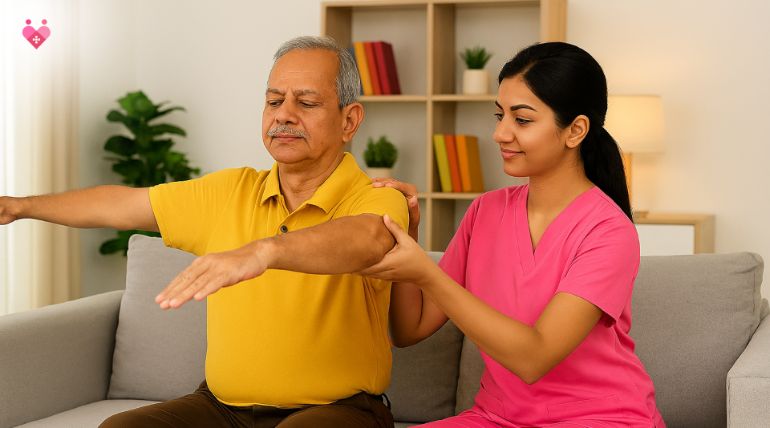
Growing older has its fair share of joy and challenges. Ageing means more time for reading, reminiscing, maybe spoiling grandkids, and enjoying sunsets and sunrises daily. The challenges of growing old include stiff joints, continuous pain, slower walking, and worries about falling. The problem increases if any older adult is recovering from surgery. Seeing your loved ones in pain and struggling with daily chores leaves family members heartbroken. But instead of teary eyes, it is time to take the right action.
That’s where physiotherapy for senior citizens, especially senior care physiotherapy at home (in case of surgery recovery), makes a big difference. If you or someone you love is considering getting such care, this is your guide to know everything about at-home physiotherapy for seniors. It includes what it is, how it helps, what to expect, and how AgeWell Care can help make it work beautifully and with no hassles.
What Is Senior Care Physiotherapy at Home?
Physiotherapy for senior citizens means specialized physical therapy aimed at the unique needs of older adults, including muscle weakness, balance loss, arthritis, neurological changes, recovery after operations, and frailty.
When you opt for the at-home Physiotherapy service for elders, the therapist visits you (or your parent/grandparent) in their living space. The therapist assesses how the body functions in that space, identifies what helps or hinders movement, and designs exercises, manual therapy, strategies, assistive aids, etc., all in the comfort of familiar surroundings. That’s senior care physiotherapy at home. It is personalized, convenient, and safe for your loved ones.
Why Choose In-Home Physiotherapy? (For Seniors & Families)
There are many reasons why doing physiotherapy at home can be better than constantly going to a clinic, especially for seniors.
Here is why:
- Comfort & Reduced Stress: Being treated at home means no travel fatigue, no navigating traffic, no unfamiliar surroundings. Seniors often feel less anxious when they are where they feel safe.
- Personalized Care that “Fits” Your Space & Routine: The therapist sees your home—the chair you use, the stairs, bathroom, rugs, lighting—and adapts exercises to what you actually do every day.
- Better Safety: The therapist can spot tripping hazards, poor lighting, loose carpets, and ill-placed furniture and then suggest modifications. Also, balance training and fall-prevention exercises work best when done in one’s own space.
- Faster Recovery & Consistency: Regular sessions at home tend to lead to better follow-through, more frequent exercise practice, and, therefore, better outcomes (mobility, pain, strength).
- Better for Chronic Conditions: For issues like arthritis, osteoarthritis, neurological conditions (stroke, Parkinson’s), or after surgery, home-based physiotherapy helps manage symptoms, reduce pain, and prevent worsening.
- Emotional, Mental Health Boost: Regaining mobility or reducing pain brings more than physical benefit. It improves mood, confidence, and sense of independence, and it reduces feelings of helplessness and loneliness.
- Family and Caregiver Involvement: At home, family members or caregivers can observe, learn, help with exercises, and understand what is safe and what is not. This supports continuity and better elder care.
Common Conditions & Situations That Often Benefit
Here are examples of when in-home senior care physiotherapy is beneficial:
| Condition / Situation | How Physiotherapy Helps at Home |
| Post-surgery recovery (hip, knee replacements, etc.) | It helps with regaining strength, range of motion, walking safely, and reducing swelling. |
| Following a hospital stay or illness | Prevents deconditioning (muscle weakening), helps return to daily routines. |
| Balance issues and risk of falls | Balance training, environment adjustments, and gait training to avoid injuries. |
| Chronic pain / arthritis / stiffness | Tailored stretches and strengthening to manage pain, preserve flexibility. |
| Neurological conditions (stroke, Parkinson’s, etc.) | It helps regain movement, manage residual deficits, and train compensatory strategies. |
| Frailty or reduced mobility due to age | Slow, safe strengthening/resistance work, boosting endurance, and maintaining independence. |
What Happens in a Home Physiotherapy Session
Knowing what to expect helps calm nerves and improve outcomes. Here’s how a typical physiotherapy session/program might look:
Initial Assessment
The physiotherapist will examine the medical history (past surgeries, chronic illnesses, medications), goals, and challenges (pain, stiffness, balance, mobility), and observe how they move in their own space.
Goal Setting
Short-term goals (e.g., “walk from bedroom to kitchen without using hands in two weeks”) and long-term goals (maintain independence, avoid falls, manage pain) should be realistic and meaningful. This session will help you decide on goals that align with the needs of senior citizens.
Design of a Personalized Plan
Based on the assessment, a mix of these exercises will be included in the plan:
- Strength & Flexibility Exercises (leg raises, gentle squats, stretches)
- Balance & Mobility Training (standing on one foot, heel-toe walking, stairs practice)
- Pain-relief / Manual Techniques (massage, joint mobilization)
- Assistive Devices & Adaptive Strategies (walkers, canes, rails, home layout modifications)
- Education: posture, how to move safely, and what to avoid.
Sessions & Frequency
It could be daily initially or several times a week, then tapering. Regular follow-ups will adjust the plan as progress is made.
Home Exercises / Between-Sessions Practice
Usually, there will be a set of exercises to do between therapist visits. These help maintain progress.
Monitoring & Adaptation
The therapist checks progress, pain levels, mobility changes, and modifies the plan (more/less intensity, new exercises).
Key Principles of Good Physiotherapy for Seniors
To make sure the service is effective, safe, and valuable, here are what to look for and ensure before continuing with your existing physiotherapy session:
- Geriatric specialization: The therapist should understand the ageing body and its challenges, like frailty, comorbidities, and slower healing. Therapy should be adapted accordingly.
- A Holistic approach: Physical, pain, mobility, environment, and mental health. It’s not just about “fixing the knee,” but “can you climb stairs, go to the bathroom safely, and feel confident walking outside?”
- Patient-centred goals: What matters to the senior? If their goal is walking in the garden, going to the temple, standing up without help, etc., treatment should aim at that.
- Safety first: Avoid exercises that risk injury. Always consider heart health, balance, and risk of falls in seniors.
- Consistency & adherence: It only works if you keep it up. Home plan + therapist support = great outcomes + faster recovery.
- Environmental awareness: Your therapist should inspect your home and suggest changes if necessary (e.g., removing rugs, installing handrails, improving lighting).
- Communication and feedback: If something hurts, change it. If you’re fatigued, adjust. If exercises are too easy or too hard, tell your physio. Be clear with the requirements for better and effective results.
What’s a Realistic Timeline & Expectation
You might wonder, “How fast will I see Physiotherapy results?” As every individual is different, the treatment will show effects differently; hence, the duration will vary. Here’s a rough idea:
- First week or two: You might feel mild soreness from exercises. You’ll notice small changes: walking more comfortably and less stiffness in the mornings or after resting.
- Within 4-6 weeks: Better range of motion, less pain, and you could do something you couldn’t do earlier, e.g., climb stairs or stand longer. Balance might feel steadier.
- Over 2-3 months: You become stronger and more confident, and daily tasks become easier. You may use fewer assistive devices for better movement. Progress may slow, but it tends to be sustainable.
Be patient. Some changes are gradual. The key is sticking with the plan, even if it’s slow.
Common Challenges & How to Overcome Them
Even with everything set, a few bumps often come up. Here are some ways to deal with the challenges in Physiotherapy for seniors:
| Challenge | What to Do |
| Pain or discomfort during exercise | Tell your physiotherapist. They can adjust the intensity, switch to gentler options. Warm up, do slow movements. Use ice/heat if advised. |
| Lack of motivation or forgetting exercises | Pair up with a family member or caregiver who helps remind, do with you. Use a chart or schedule. Celebrate small wins. |
| Fear of falling | Start with support (chair, wall, therapist’s help). Progress slowly. Ensure safety measures in home. |
| Fatigue or health setbacks (illness, other chronic conditions) | Adjust the plan. Sometimes rest or low-intensity sessions are needed. Monitor vital signs if relevant. |
| Cost, logistics of physiotherapist visit | Explore local providers, check with insurance if any covers, government or NGO programs. Sometimes remote or hybrid options. |
How to Choose the Right Home Physiotherapy Service for Seniors
Here are things to check when selecting an at-home senior care physiotherapy service provider:
- Qualifications & Experience: Licensed physiotherapist, ideally with experience in geriatrics, neurological rehab, and post-surgical rehab.
- Assessments & Goal Setting: They should start with a thorough assessment and set clear goals with you.
- Adaptability & Flexibility: Able to adjust schedule, intensity, and tactics based on feedback.
- Support & Communication: Clear communication is the key. Make sure the therapist teaches you and your family how to do home exercises, safe transfers, etc. This will be beneficial in the long run.
- Safety Measures: The right physiotherapist will check the home, know how to prevent falls, and work towards balancing seniors and family members so they are on the right path of elder care.
- Transparent Pricing: Know the cost per session, any extra charges, equipment cost, etc. These small things need transparency and clarity from the beginning of the physiotherapy session for seniors.
Safety Tips for Doing Physiotherapy at Home
Whenever doing physical therapy at home, either with or without the therapist there, keep these in mind:
- Clear clutter. Remove rugs, cords, and anything you can trip over.
- Good lighting, especially in old homes or in the evenings.
- Use appropriate footwear. No slippery socks; supportive shoes are better.
- Assistive supports like railings or chairs should be stable.
- Always follow warm-ups and cool-downs.
- Don’t push through sharp pain. Mild discomfort is okay; sharp or sudden pain means stopping and telling the physio.
These minute but critical things need to be considered before setting up the home for a Physiotherapy session for seniors at home to avoid any major/minor accident.
Costs, Insurance & Accessibility (Especially in India)
In many places, home physiotherapy is extra-costly because of the therapist’s travel time, special equipment if needed, etc. However, it often saves in the long run for seniors trying to avoid rehospitalization or complications.
Things to check:
- Whether insurance or health plans cover physiotherapy or home visits.
- Whether there are government schemes, NGOs, or charitable services in your area.
- Frequency that’s needed vs. what you can afford; sometimes fewer visits + more self-practice is workable.
AgeWell Care – Your Experienced Partner in At-Home Physiotherapy Sessions for Seniors
Here’s how AgeWell Care can support seniors and their families when it comes to physiotherapy for senior citizens at home.
- Home physiotherapy programs are tailored to the needs of the elderly, including strength, balance, flexibility, and pain management.
- Post-operative mobilization & recovery support after surgeries such as knee/hip, or after hospital stays.
- Fall risk assessment & prevention – reviewing home environment, training balance, and providing assistive aids.
- Neurological rehabilitation (for stroke, Parkinson’s, etc.): helping senior citizens regain or maintain movement and coordination.
- Pain relief therapies – manual therapy, massage, heat/cold, and gentle mobilization to reduce stiffness and discomfort.
- Caregiver training & family support – teaching family/caregivers safe ways to assist, helping with exercises, and understanding limitations to help seniors better.
- Coordination with medical professionals: Working with doctors and surgeons for holistic senior care physiotherapy.
- Adaptive equipment and modifications: Rails, grips, walkers, or environmental changes in the home are recommended to support function and safety.
AgeWell Care is the most trusted at-home elder care service provider in Kolkata. With its team of trusted wellness managers and wellness attendants, AgeWell aims to help seniors live safe, comfortable, and healthy lives with dignity. So, when in need, don’t think beyond AgeWell Care. You won’t regret your decision.
Making a Plan: Putting It All Together
Here’s a step-by-step plan you or your family can follow to start physiotherapy for senior citizens at home:
- List out problems & goals – What hurts, what limits you? What do you want to be able to do?
- Get a medical check to rule out conditions that require physician care first (e.g., heart issues, serious neurological problems).
- Find a qualified physiotherapist with experience in senior care physiotherapy. Ask about their home-visit services.
- Do the initial assessment together with the therapist. Show them your home and routine.
- Create a schedule and a home exercise plan (HEP). Ensure you have any needed equipment (elastic bands, chair, mat, etc.).
- Make small changes to your home environment for safety.
- Keep at it. Do the exercises regularly. Keep tracking your progress (pain, ability, and feeling balanced).
- Reassess every few weeks. Adjust plan. Celebrate gains. If something’s not working, speak up.
Summary: Why Physiotherapy for Seniors is Worth
To wrap up, here’s what physiotherapy for senior citizens at home offers:
- Improved mobility, flexibility, and strength
- Reduced pain, stiffness, and improved range of motion
- Better balance, fewer falls
- Greater confidence, more independence
- Convenience, comfort, and less stress
- Home-friendly plans
It’s an investment in quality of life, helping seniors stay active, safe, and independent. If you’re considering it, you’re already taking a big step in the right direction.
Final Thoughts
If you or your loved ones are considering starting physiotherapy at home, go for it. Ask questions, pick someone experienced with senior citizens, set realistic goals, and, most importantly, pace yourself.
The road may not always be smooth, but each step—literally and figuratively—can bring positive change.




